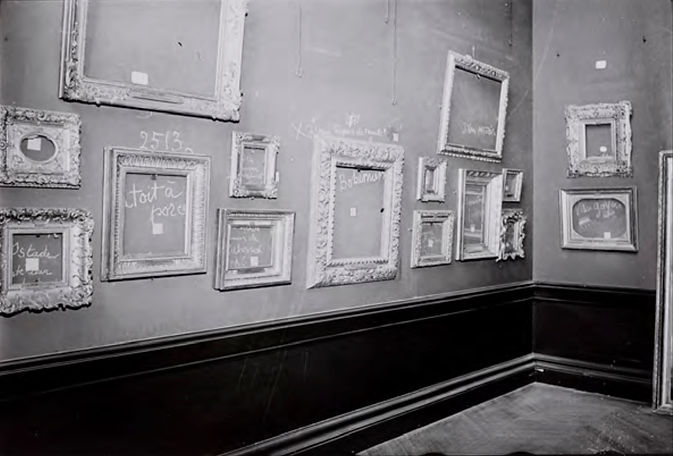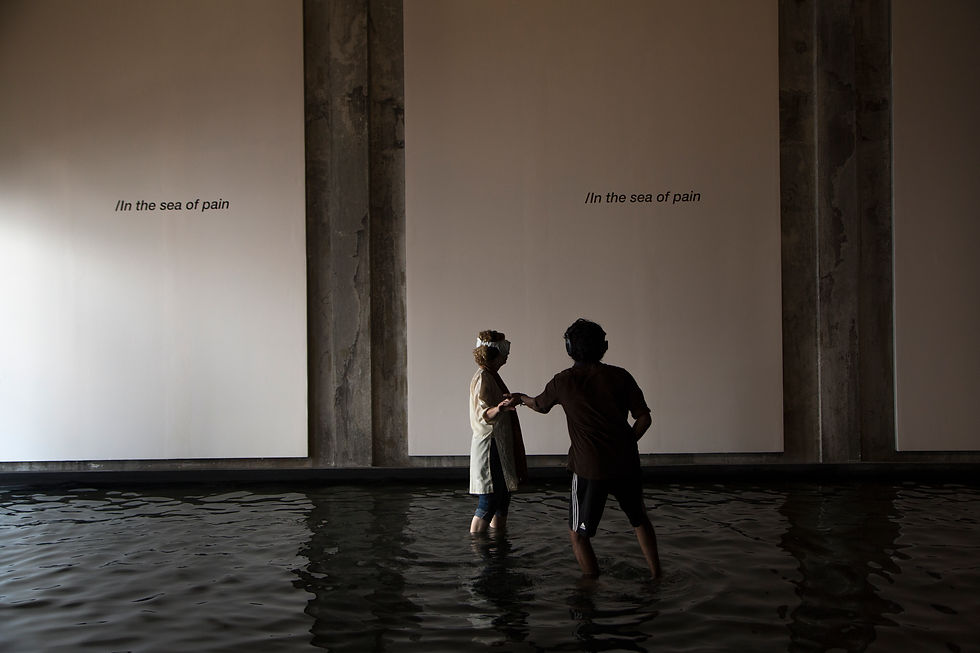ART'S NEW NATURES
LUNDAHL & SEITL
AmissingRoom (2020) by Lundahl & Seitl
In response to the coronavirus pandemic, digitalization and surveillance accelerated, laws were reconstituted and living habits altered around the world.
"AmissingRoom" (2020) is an app that transforms our smartphones into makeshift VR goggles through a physical process between two people. It is a score of moving, sensing and being affected by the absences created by the pandemic, such as the closing of museums and theatres, but it is also the tangible presence of exploring the affordances of reciprocity and the conditions for being together in times of physical distancing.
Passing through walls into tunnels that travel through a network of past exhibitions and museums, people interact with each other but somewhat fail to coincide and share each other’s realities. By enacting the artwork’s score, the two people are led to consider how they balance resilience and resistance when adapting to a changing environment.
Download the free app
APP STORE GOOGLE PLAY





Father and son in Sweden

AmissingRoom, 2020. Two people experiencing AmissingRoom in front of a quarantine window in HongKong. Image: Julia Mauroy

Symphony - The Mnemosyne Revolution and Symphony of a Missing Room (2016) at ‘An Imagined Museum’, Centre Pompidou, Metz
In March 2020, with lockdowns postponing or cancelling most cultural events for the rest of the year, we had asked ourselves; could our artwork "Symphony of a Missing Room" which is dependent on physical museum space and visitors, at least temporarily survive through adaptation outside the settings of a cultural institution?
"Symphony of a Missing Room" was conceived in and for the context of museums, with over a decade of research; a multitude of ideas, thoughts and reflections from over 20 international museums and biennales, virtually accumulated inside its body.
It is reminiscent of how individuals from different generations live side by side, interact with each other, but somewhat fail to coincide and share each other’s realities. Inside the missing room, visitors pass through walls, into tunnels that travel through a network of past exhibitions and museums. Other artists, dead and alive, far and near, echo inside the symphony as an infinite conversation.


Left: The Royal Academy of Arts, London Right: Acropolis Museum, Athens
"Symphony" therefore transmuted into the app AmissingRoom: a score for two people to enact the artwork in a domestic setting. It is a digital artwork that turns mobile screens into projector lights. By alternating between receiving and guiding roles, throughout the experience the partners are asked to close their eyes and follow a score of choreographed suggestions. In tandem with a three-dimensional sound in headphones the process augments a virtual room, shared only between the two of you.

Lundahl & Seitl: ‘Symphony – Tunnel Vision,’ 2015 at Momentum 8 – Tunnel Vision, 2015. Nordic Biennale of Contemporary Art, Momentum Kunsthall and Galleri F 15, Moss, Norway // Courtesy of the artist
The artwork AmissingRoom places us in a liminal room, a speculative future where coming generations no longer share our present perceptual sensibilities to experience art. AmissingRoom is nothing that you look at on a screen, as with Visual AR artworks where a digital object appears superimposed in the room. Rather, it is a process between two people using their phones as makeshift VR headsets.
The artwork is thus the phenomena that emerge. More than the sum of its parts, it is a reciprocal space with dimensions measured and received by the participants' imaginations.

Paul Almasy: ‘Louvre, Paris,’ 1942 // © the artist and akg-images / Kleinschmidt Fine Photographs
In March this year, the experience of physical distancing brought forward a memory of the above image by Paul Almásy: Louvre, Paris, 1942, showing empty frame apertures with artist names and inventory numbers for each absent painting inscribed inside. This was the result of the entire museum collection of the Louvre being evacuated to the French countryside during the war. The photograph by Almásy was the leitmotiv for the exhibition An Imagined Museum, 2016 - 2017, at which Lundahl & Seitl's work Symphony - The Mnemosyne Revolution was included, conjuring a fictional situation in which the works of art on display are about to disappear. It was the result of a collaboration between Centre Pompidou-Metz. Tate Liverpool and MMK Frankfurt.
This image from 1942, although loaded with the darkness of war, discovered a presence through absence. When art objects are removed, censored or destroyed from our environment - how long do we still have the capacity to experience art through the projections of our memory and imagination? In times of times of crisis, how does art adapt to the new environment and in what form does it take place?

Symphony – Mnemosyne Revolution was exhibited 100 days at the 2nd Kochi Muziris Biennale: ‘forming in the pupil of an eye’, India, 2016-2017, curated by Sudarshan Shetty. Collection of the artists. The image is showing the ‘The Sea of Pain’ by Raul Zurita. The Chilean poet dedicates this work to Galip Kurdi the brother of Alan Kurdi, the three year-old boy who was washed ashore a beach on the second of September 2015, his image becomes synonymous with the Syrian refugee crisis. Image Courtesy Kochi Muziris Foundation
Symphony of a Missing Room questions how we are present with each other and in relation to our physical surroundings, and how our technological devices shape our habits and expectations of reality.
It induces a somewhat ritualistic choreography that operates as a score for practicing sensory awareness on a higher bandwidth so to not accept living in a reality reduced to information on flat screens. It is a reminder not to forget what it feels like to be fully present with each other and in our bodies.

Christer Lundahl & Martina Seitl. Photo: Sergei Munchin
Lundahl & Seitl
With backgrounds in visual art and choreography, Lundahl & Seitl are a pioneering post-disciplinary artistic collaboration that interrogates the nature of being. By appropriating different art forms, methods and technologies, they create immersive installations, fostering resonance between the connectivity and interdependence that exists within any given environment, between a world and its inhabitants.
Lundahl & Seitl are supported by The Swedish Arts Grants Committee's International Program for Visual Artists (iaspis), Kulturrådet Sweden / Swedish Arts Council, and the British Council.
Read more: lundahl-seitl.com/about
Creative technology by DVA Studio
Thanks and credits to:
Nandi Nobel (Designer of the App’s symbols), Emma Ward (Production), Rachel Alexander and Sara Lindström (Dramaturgy and choreography), Genevieve Maxwell, Lisette Drangert, Laura Hemming Love, Catherine Hoffman, Pia Nordin, Moa Hansen, Colin McLean, Lisen Ellard, Lena Kimming (Performers in the Symphony Series since 2009). Voices: Alba Lundahl Seitl & Saskia Vasovic Stefansdotter.